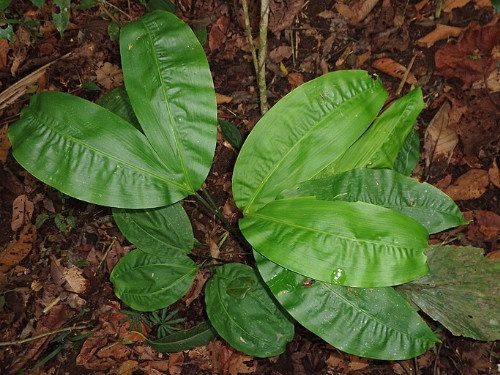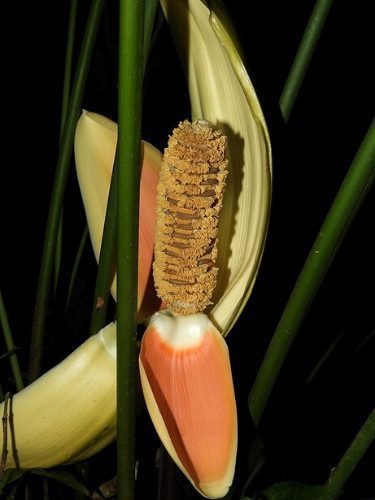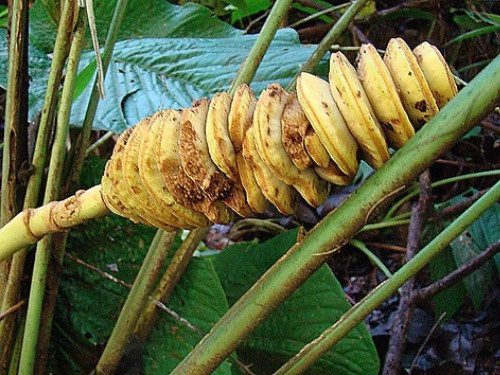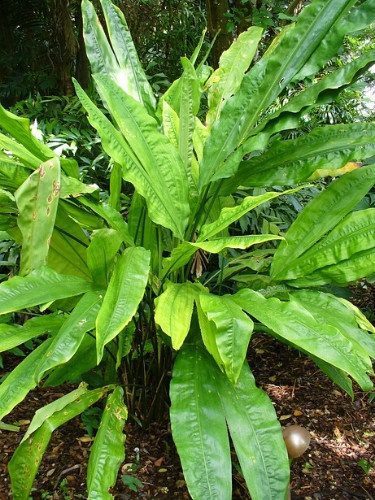
Split-leaf Cyclanthus (Cyclanthus bipartitus) is an herbaceous, clumping, perennial species known for its crinkled and bipartite foliage, giving the impression that each leaf is actually two. Native to the Amazon region, it thrives as a marsh plant in streams, lowlands, and damp areas, often sheltered by the canopy of trees. Some botanists describe it as having a short rhizome, while others depict it as stemless, giving the appearance that its leaves emerge directly from the ground. The leaves grow in dense clumps, boasting a light green, glossy hue. They are large, broad, upright, leathery, supported by long petioles, bipartite in mature individuals (with falcate lobes), and exhibit a distinctive “crumpled” texture.
The inflorescence of Split-leaf Cyclanthus can appear at any time of the year, on taller or shorter stems, in the form of a spadix with a spiral appearance. It features alternating rings of pistillate and staminate flowers and four large spathes at its base. The flowers are cream-colored and small, offering little to no ornamental value. However, the spathes are highly fragrant, releasing a delightful scent of vanilla and cinnamon. After pollination, which is carried out by beetles, the fruits develop and eventually detach into discs, releasing the seeds.

Split-leaf Cyclanthus is increasingly used in landscaping projects, offering an intriguing choice for semi-shaded to shaded areas. When grown in beds, forming masses or rows along walls, it adds significant ornamental value. It is also a quintessential marsh plant, capable of adding texture to the edges of ponds and water mirrors, infusing tropical and contemporary vibes into gardens of various sizes—be they residential, commercial, or communal spaces.
Moreover, it serves as an excellent option for indoor spaces, thriving in large pots and winter gardens. Exercise caution with the “scale” when using Split-leaf Cyclanthus, as its sizable foliage can potentially dominate spaces. Reserve its unique texture for expansive environments, where it will bring exclusivity and elegance.
Overall, it’s a hardy and low-maintenance plant, requiring minimal care, primarily involving dust removal from the leaves using a clean, damp cloth or a gentle shower with cold water. Pruning should be limited to the removal of dead or yellowing leaves for aesthetic purposes.

Cultivate Split-leaf Cyclanthus in partial shade or filtered light and use substrates rich in organic matter that retain moisture. For the substrate, consider mixing clayey soil with compost. Peat and pine bark can also be added to increase aeration and moisture retention. Avoid exposing Split-leaf Cyclanthus to direct sunlight, especially during the hottest hours of the day, as it can lead to irreversible burns.
As an essentially aquatic plant, the soil should remain consistently moist without becoming waterlogged. It thrives in warm and humid climates, so it’s best to avoid air conditioning and enhance air humidity with humidifiers. In temperate or subtropical climates, it’s preferable to cultivate Split-leaf Cyclanthus in protected environments, such as indoors or in humid greenhouses. It is intolerant of frost and drought.
Fertilization should occur during the growing season—spring and summer—with moderate amounts of organic or mineral fertilizers applied in the area under the foliage projection, without touching the plant’s base. Remember to water the plant before fertilizing to prevent root burns. Split-leaf Cyclanthus is typically propagated through clump division, leaf cuttings (with petioles), or seeds, at any time of the year.


